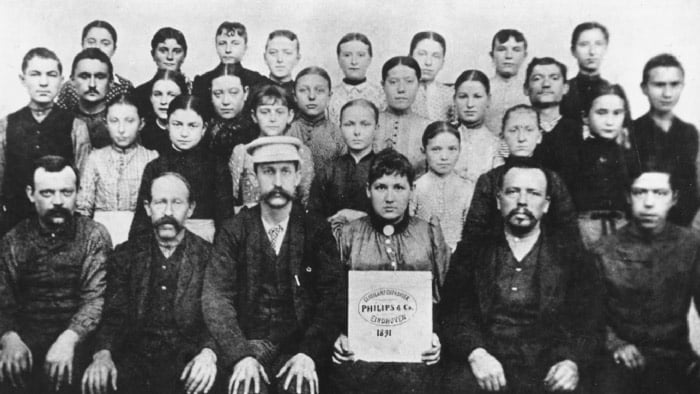Growing up, I remember the warm, crackling sound of our old Philips radio filling the house with music and news. It wasn’t just a device; it was a connection to the world beyond our home. As the years went by, I saw Philips evolve, transitioning from radios to cassette players, and later, into the world of advanced health technology. Their ability to stay in tune with the needs of each era has always fascinated me—delivering products that entertained, informed, and ultimately enhanced our lives. Uncover the advanced capabilities of the Philips 5500 LatteGo review
Humble Origins: The Founding of Philips
Philips was founded in 1891 by Gerard Philips and his father, Frederik, in Eindhoven, Netherlands. The company’s first product was a carbon-filament lamp, and from these modest beginnings, they began shaping a future of innovation. Despite facing financial hurdles and fierce competition, Philips’ dedication to quality and continuous improvement propelled them toward success. What began as a small factory would soon become a global force that would revolutionize multiple industries. Get a closer look at the features of the Philips 5400 LatteGo review
Early Growth and Groundbreaking Innovation
By the early 20th century, Philips was already one of Europe’s largest manufacturers of light bulbs. This rapid expansion was powered not only by mass production but also by their commitment to innovation. A pivotal moment came in 1914 when Philips established its Research Laboratory, also known as NatLab. NatLab became a hotbed for scientific exploration, leading to a wave of discoveries that laid the foundation for Philips’ future technological breakthroughs. Compare these two machines side by side in the Philips LatteGo 5400 vs 4300 review
Breaking Into Radio Technology
In the 1920s and 1930s, Philips saw the growing importance of radio as a new form of communication. By 1927, they began producing radios that quickly gained popularity for their affordability and superior quality. Within just five years, Philips had sold over a million radios. This success solidified their reputation as leaders in consumer electronics, ahead of the curve in embracing new technologies. Discover the differences among these models in the Philips 3200 vs 4300 vs 5400 review

Perseverance During World War II
World War II presented significant challenges for Philips, with their operations disrupted and facilities damaged. However, the company’s resilience shone through. Key personnel were relocated to safer locations, and despite the turmoil, research continued. During the war, Philips also contributed to technological advancements in radar and other fields, demonstrating a remarkable ability to adapt and innovate even in the most difficult circumstances. Learn how these two models compare in the Philips 3200 vs 4300 review
Post-War Growth and the Invention of the Cassette Tape
The post-war years saw Philips embark on a period of rapid growth. One of the company’s most transformative innovations came in 1963 with the introduction of the compact audio cassette. This invention revolutionized the way people listened to music, offering a portable and affordable medium for recording and playback. The cassette tape dominated the market for decades, transforming the music industry and consumer behavior. See what sets these models apart in the Philips 3200 vs 5400 review
Shaping the Future of Music: The Compact Disc
In the late 1970s, Philips formed a partnership with Sony to create the compact disc (CD). This collaboration led to the birth of a new, durable digital audio format that quickly replaced the cassette tape as the standard for music playback. The CD became a global phenomenon, cementing Philips’ reputation as a pioneer in the music industry and pushing the boundaries of digital technology. Get a detailed review of the Philips LatteGo 5400 review
Diversifying into Consumer Electronics and Television
As the 20th century progressed, Philips diversified into various areas of consumer electronics. The company played a key role in developing home entertainment technologies, including the VHS tape format and the DVD, which transformed how people watched movies at home. In the 1990s, Philips also introduced the groundbreaking Ambilight TV, which enhanced the viewing experience by projecting ambient light around the screen—an innovation that was ahead of its time. Discover the compact and efficient design of the Philips 3200 LatteGo review
A Shift Toward Healthcare Technology
Recognizing the changing demands of the global market, Philips began investing heavily in healthcare technology in the 1980s. The company expanded into medical imaging, patient monitoring, and health informatics, positioning itself as a leader in the healthcare sector. Strategic acquisitions and a strong focus on innovation allowed Philips to develop a comprehensive healthcare portfolio aimed at improving patient care, boosting efficiency, and advancing medical research. Dive into the advanced features of the Philips 4300 LatteGo review
Transitioning to Health Tech: A New Era
In recent years, Philips has made a major shift away from traditional consumer electronics, refocusing on health technology and lighting solutions. In 2016, the company spun off its lighting division as Signify, allowing Philips to concentrate fully on health innovations. Today, Philips is at the forefront of connected care, digital health solutions, and advanced medical devices, aligning its mission with the growing global emphasis on health, wellness, and preventive care.
Commitment to Sustainability and Social Responsibility
Throughout its history, Philips has been committed to sustainability and corporate responsibility. The company has set ambitious goals, including achieving carbon-neutral operations and embracing circular economy principles. Philips’ sustainability initiatives are deeply intertwined with its health technology mission, as the company aims to develop products that have a positive impact on both society and the environment.
Embracing Digital Health and AI Integration
As the world moves toward digital solutions, Philips has embraced technologies like artificial intelligence (AI) and data analytics to enhance its healthcare offerings. The company has integrated AI into connected care solutions, improving healthcare efficiency and outcomes. By focusing on personalized health solutions, AI-driven diagnostics, and connected devices, Philips is shaping the future of healthcare, ensuring that technology plays a central role in improving patient care and well-being.

Conclusion: A Legacy of Innovation and Resilience
Philips’ journey from a small light bulb manufacturer in Eindhoven to a global leader in health technology is a remarkable story of resilience, adaptability, and continuous innovation. Their impact can be seen across industries, from revolutionizing home entertainment to transforming healthcare delivery.
As Philips continues to innovate and push the boundaries of technology, its legacy remains a powerful reminder of how perseverance, creativity, and a commitment to improving lives can lead to lasting success. With its ongoing focus on advancing health technologies, the future of Philips promises to be as dynamic and impactful as its storied past.
FAQ
Q: When was Philips founded?
A: Philips was founded in 1891 by Gerard Philips and his father, Frederik Philips, in Eindhoven, Netherlands.
Q: What was Philips' first product?
A: The first product manufactured by Philips was the carbon-filament lamp.
Q: What is NatLab, and why is it significant?
A: NatLab, or the Philips Research Laboratory, was established in 1914 and played a crucial role in fostering innovation within the company, driving future breakthroughs in technology.
Q: How did Philips contribute to the music industry?
A: Philips revolutionized the music industry twice: first by introducing the compact audio cassette in 1963, and then by collaborating with Sony to launch the compact disc (CD) in the late 1970s.
Q: What major change did Philips undergo in recent years?
A: In recent years, Philips shifted its focus from traditional consumer electronics to health technology, spinning off its lighting division as Signify and concentrating on health-related innovations.
Q: How is Philips contributing to healthcare today?
A: Philips is focusing on connected care, medical imaging, patient monitoring, and health informatics, aiming to improve healthcare quality and patient outcomes through advanced technological solutions.
Q: What sustainability initiatives has Philips undertaken?
A: Philips has committed to sustainability by aiming for carbon-neutral operations, adopting circular economy practices, and striving to create products that contribute positively to society and the environment.
